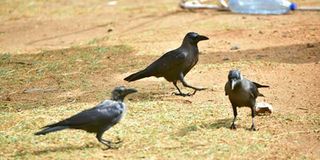Mombasa County seeks partners to eradicate Indian house crow

Indian house crows in Mombasa on April 24, 2019. The birds are wreaking havoc as they invade homes and hotels in search of food. PHOTO | KEVIN ODIT | NATION MEDIA GROUP
The Indian house crow, considered an invasive pest by scientists, has been wreaking havoc at beach hotels in Mombasa for years, “disturbing” holidaymakers and stealing their food.
In 2018, the county government decided to do something about it. In its medium-term draft budget for 2018/2019, some Sh30 million was to be used to eradicate the birds in the tourism hub within five years.
But after residents objected to the planned expenditure, officials dropped the plans.
The decision is now haunting residents and hoteliers, who are grappling with an explosion in the number of Indian house crows in the city.
The birds, commonly known as kunguru or kurabu, are a nuisance, preventing tourists and residents from holding outdoor activities and stealing guests’ food in open-air eateries.
Hotels have employed various strategies to deal with the birds, including deploying workers to scare them away at meal times.
However, officials have assured stakeholders that they are seeking donors and partners to eradicate the birds.
“We wanted to address the crow menace as a county. Two years ago, during our budget-making process, we included it in our plans but we followed what mwananchi said. The citizens at that particular time did not approve it,” said Environment Chief Officer Ilhan Abbas.
“However, we believe we can create a safer environment if we get some partnerships and donors to support us in eradicating the pests.”
The birds are ruining the county’s image as a tourist hub. But several beach resorts have invested in catapults to scare away the crows.
The aggressive birds mostly scavenge at the Mwakirunge and Shonda dumpsites. In Mwakirunge, they are a threat to aviation as they can block the flight paths of planes landing or taking off from Moi International Airport.
Tourism players, led by the Kenya Association of Hotelkeepers and Caterers (KAHC) Coast branch executive officer Sam Ikwaye, said counties should invest in eradicating the pests.
“Aviation players have been complaining about the birds, because they are a threat to the sector. Whenever there is no food in Mombasa they shift to Kwale or Kilifi. Other counties should start the campaign to eradicate the pests,” Dr Ikwaye added.
The tourism expert said the birds are denying tourists ample time to revel especially at the beaches during the day.
He said it is difficult for the players to sell tourism products such as bird watching after the Indian house crow ate almost all the indigenous species.
A source told the Nation that Kenya Wildlife Service (KWS) was looking for money in its budget to deal with the birds.
“We need a budget for eradicating the birds, ecosystem balance and mood of ‘killing’ them. But a study was to be conducted by KWS,” the source said.
Environment watchdog Nema said only KWS has the mandate to deal with the birds.
“It is KWS who are actually supposed to deal with that thing. Our work is to do environmental impact assessment, public consultation so that we can verify whatever they want to do is acceptable to everybody, but it is the county and KWS who can do that. But people are complaining, especially hoteliers, saying it’s a nuisance,” said Nema official Samuel Lopokoiyit.
He said biologists are also complaining that the birds are killing other species.
“It’s not only about allocating resources. Dealing with this issue (requires) a thorough study to avoid impact on human beings, animals and our ecosystem,” he said.





